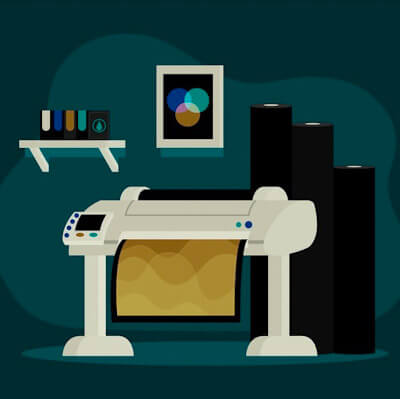

The printing industry is a diversified industry that uses a variety of printing technologies to print on a wide range of substrates such as paper, polymers, metals and other materials. There are significant differences between printers' waste management procedures and the amount of waste they send to landfill.
Wastes-Pre-press Operations method is generating typical photographical wastes (developer, fixer and wash waters) and empty containers.
1. Lithographic Printing- utilizes a metal plate that has been coated to either attract or repel ink. The offset process is when the ink is applied via an intermediate rubber roller. Sheet-fed or web-fed paper can be used in the lithographic process with web-fed paper coming in a continuous roll.
Processing Wastes- Waste inks, cleaning solutions and paper or substrate waste, as well as old plates, plate treatment wastes, evaporated hydrocarbons and oils.
2. Rotogravure printing- Rotogravure printing is an intaglio printing technique in which the image is engraved onto an image carrier. In rotogravure printing, the image is acid-etched in a pattern of cells on the surface of a metal cylinder—one cylinder for each color. Unlike relief or letterpress printing, where the image is raised, or offset printing, where the image is level with the plate, the cells are sunken into the cylinder. Cells of varying depths are etched into the cylinder. The ink that is deposited to the substrate is held in these cells. Because deeper cells create more intense color than shallow cells, the cell diameters must be accurate.
The cells are filled with ink, and the non-printing areas of the plate or cylinder are cleaned or scraped clean using a doctor blade. Unlike offset printing, which employs an interim cylinder, the image is transmitted directly to the medium when paper or another substrate is pressed against the inked cylinder on a rotary press. On each turn of the press, the engraved cylinder is partially immersed in the ink fountain, where it picks up ink to fill its recessed cells.
Processing Wastes- Cleaning solvents and evaporated solvents, usually hydrocarbons and paper or substrate waste, old plates, waste acid, etching solutions, waste inks,
3. Flexographic printing- Flexographic printing prints directly onto the print material using a plate with a raised surface (relief printing) and rapid drying fluid inks. The plates are mounted to a drum on rotary printing equipment and are made of rubber or photosensitive polymeric substance called photopolymer. Flexography uses a flexible printing plate wrapped around a rotating cylinder to produce images. Double-sided adhesive tape is commonly used to secure the plate to the cylinder.
Processing Wastes- Old plates, residual materials from the flexible plate manufacturing process, cleaning solvents, waste inks, solvents evaporated during the ink drying process, and paper or substrate waste
4. Letter Press- To transfer ink to paper, flat metal or plastic plates with raised designs are used. Ink is dried in the same way as flexography printing is done.
Processing Wastes- Cleaning solutions, waste inks and paper waste, old plates and moulds, plate developer solutions.
5. Screen Printing- A stencil is attached on a porous polyester mesh that has been stretched. The open spaces in the stencil allow ink to travel through and onto the substrate material.
Processing Wastes- Waste inks, block out, screen reclamation chemicals, paper or substrate wastes, old screens, screen and stencil wastes.
6. Photocopying- A charge is imparted onto a sensitive drum by photographic or laser processes, which picks up a power toner (ink) and transmits it to paper. The toner is melted or bonded to the paper by a fixer unit.
Processing Wastes- Developer powder (a magnetic ferrite material), waste paper, spent toner cartridges (some use wax blocks as toner, especially for color photocopying)
7. Digital Printing- Laser operations are used to inject a charge onto a sensitive drum, which picks up and transfers a specific ink to paper. The method is similar to photocopying, but it may be done on a much bigger scale and with different inks and toners.
Processing Wastes- Developer powder (a magnetic ferrite material), waste paper and redundant computer and IT equipment, spent inks or toner cartridges.
8. Post printing processes- Stapling, glues, threads, laminating, cutting, scoring, creasing, and specific shaping are all used in binding and collating procedures. Processing Wastes- Binding materials, redundant stock, paper or substrate off cuts, glues.
How to get Pollution Certificate/NOC
Prior approval from the Concerned State Pollution Control Board (SPCB)/Pollution Control Committee (PCC) is required for any business entity interested in establishing a Roto and Flexo Printing unit. As per the provisions of the Air Act 1981 and the Water Act 1974, no person shall establish or operate any industrial facility in an air pollution control area without the prior approval of the State Pollution Control Board (SPCB)/Pollution Control Committee (PCC). Industries in India are classified as Red, Orange, Green, or White by the Central Pollution Control Board (CPCB), with each state/UT having its own set of classifications based on their location. Roto and Flexo Printing come under orange category and following certificate will be issued by Pollution Department.
For more details and information visit Metacorp
Other certificates/registrations required for setting up printing business





We are the pioneers in offering environmental consulting services to our patrons, giving us the first mover advantage & keeping us ahead of our competitors.
Very experienced in filing, monitoring & issuance of CDSCO Certificates, Drugs Licensing, Environmental Impact Assessment, AERB certificates, Pollution Control Board CTE & CTO, Waste Management Authorization from State Pollution Control Boards, Fertilizers & Insecticides Licensing
